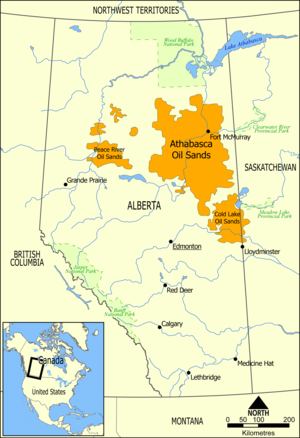
 |
| Fig. 1: The three oil sand deposits in Alberta, Canada (the Athabasca Oil Sands, the Cold Lake Oil Sands, and the Peace River Oil Sands), Source: Wikimedia Commons) |
With the hike of the oil price up to $145 in July 2008, oil sand was one of the leading unconventional petroleum resources to replace the conventional oil. The oil sands are produced mostly in Canada (figure 1). Since Canada has 176.8 billion barrels of oil sands which is about 70.8% of the total natural bitumen reserves estimated (249.67 billion barrels). [1] After the financial crisis detonated by the bankrupt of Lehman Brothers Holdings Inc. in September 2008, the oil price rapidly fell down and it deferred many on-going oil sand projects in Canada because of economic inefficiency. However, oil sand is still one of the major unconventional energy resources. The deferred oil sand projects are always ready to continue according to the oil price. In this paper, the meaning of oil sand as unconventional energy resources and what has been left after the oil sands rush in Canada will be discussed.
Oil sands is also called bituminous sands or tar sands (figure 2). However, there is a difference between oil sands and tar sands. Oil sands is a term mostly used for the bitumen deposits which is naturally occurring viscous mixture of sand, clay, water and bitumen which is extremely heavy substance. Tar is used for the artificially made substance by the destructive distillation of organic material. Therefore based on natural occurrence, the two terms should be chosen. Oil sands or natural bitumen is found in Canada with extremely large quantities and Kazakhstan and Russia has also large reserves. In Canada, oil sands production technologies have mainly two ways based on the buried depth of the bitumen. About 20% of the oil sands is recoverable less than 50m deep. In this case, typically mining and upgrading technologies are used for producing oil sands. In Canada, the estimated recoverable reserves though the technologies are about 35 billion barrels. The other 80% of the oil sands are located deeper than 50m. In this case, in-situ technologies such as Steam Assisted Gravity Drainage (SAGD) or Cyclic Steam Process (CSP) are applied. In Canada, the estimated recoverable reserves are 140 billion barrels by these technologies.
According to the Investopedia dictionary, the definition of oil reserves is "An estimate of the amount of crude oil located in a particular economic region. Oil reserves must have the potential of being extracted under current technological constraints. For example, if oil pools are located at unattainable depths, they would not be considered part of the nation's reserves." This is why the oil sands is recently considered as a part of the world's oil reserves because of high oil price and new technologies which make possible to extract the oil sands economically feasible. Since the oil sands needs these two conditions, it is referred to as unconventional oil or crude bitumen. Typically, liquid hydrocarbons produced from traditional oil wells with the pumpjack are called conventional oil. Among other unconventional petroleum deposits, oil sands is one of the important next generation energy resources because of its reserves. In 2006, Canada was ranked as second for oil reserves in the world because of 175 billion barrels of oil sands. Also with unconventional resources such as oil sands which are transformable into crude oil, people could still have a 300 year supply left.
 |
| Fig. 2: Oil sands of the lower L'Enfer Formation (Pliocene) exposed at the Stollmeyer Quarry, near Parrylands, Trinidad and Tobago. (Source: Wikimedia Commons) |
For the sustainable energy development, there are some difficulties to overcome. Fist, producing oil sands causes more CO2 than average crude oil which might violate greenhouse gas regulations. [2] For example, if the 170 billion barrels of proven reserves in the Alberta, Canada oil sands are burned, it would causes 0.02 to 0.05 °C of global warming. Second, mining operations need to clear trees and brush from a site. Even though the developers are required to restore oil sands mining sites to their previous biological productivity after the mining operations, but it is hard to expect as good as the site would be before the operation. Third, if the oil sands are tapped, the Keystone pipeline, a pipeline from the Athabasca oil sands region in northeastern Alberta, Canada to multiple destinations in the United States, would be a trigger to the huge carbon bomb on the earth. Fourth, the side effects on the environment causes higher cancer rate for human. [3,4]
As the oil price is higher, oil sands will be one of the important unconventional energy resources. Especially, its importance lies on the huge amount of reserves in Canada which can extend the energy supply about 300 of years. However, oil sands in Canada left us environmental issues such as greenhouse effect causing global warming, destruction of the site and potential huge carbon bomb. In order to have oil sands as green and sustainable energy resources for the future, environmental side effects of oil sands should be resolved though various ways such as an environmental monitoring system or solvent extraction process for oil sand bitumen. [5]
© Hyucksoo Park. The author grants permission to copy, distribute and display this work in unaltered form, with attribution to the author, for noncommercial purposes only. All other rights, including commercial rights, are reserved to the author.
[1] "Annual Energy Outlook 2007", U.S. Energy Information Administration, DOE/EIA-0383(2007), February 2006.
[2] T. Gardner, "Canada Oil Sands Emit More CO2 Than Average: Report," Reuters, 18 May 09.
[3] "Cancer Rates Downstream From Oil Sands To Be Probed", CBC News, 19 Aug 11.
[4] S. Haggett, "High Cancer Rates Confirmed Near Canada's Oil Sands," Reuters, 6 Feb 09.
[5] L. Dowdeswell et al., "A Foundation for the Future: Building an Environmental Monitoring System for the Oil Sands," Report Submitted to Environment Canada by the Oilsands Advisory Panel, December 2010.